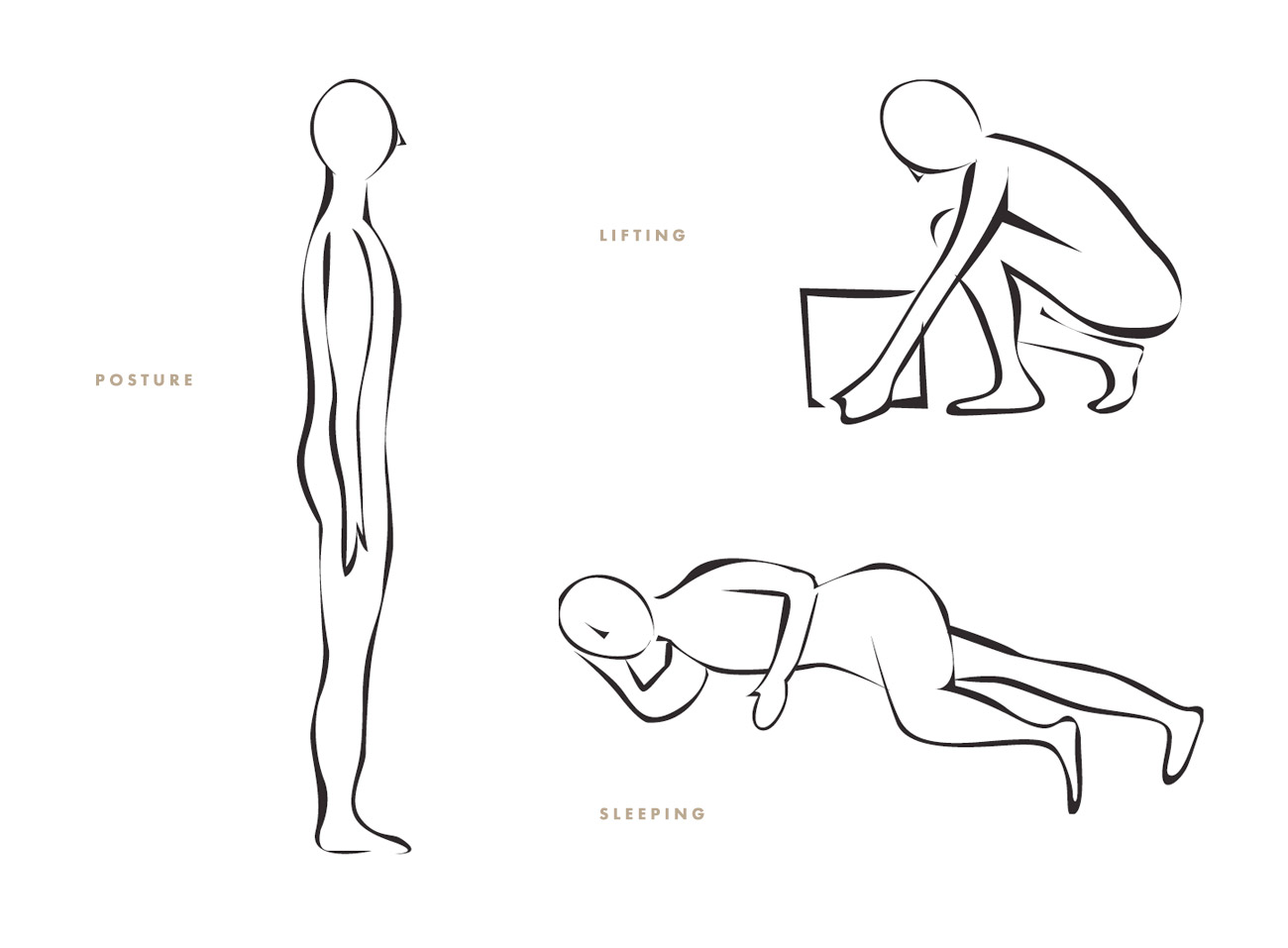RESOURCE LIBRARY
Back Pain 101: The Common Causes and How You Can Treat and Prevent Back Injury
“Oh, my aching back!”
Almost everyone experiences some type of back pain during the course of their lives. The pain may occur suddenly and be gone within a couple of days or weeks, or it may occur repeatedly, never completely going away, and have a major impact on regular daily activities.

Are poor posture or bad habits causing your back pain?
Image via Unsplash.
How your back works
Your back is a complex system of interlocking components:
• The bones or vertebrae that make up the spinal column are separated by discs, which act as shock absorbers that support and
distribute the weight of your body.
• The spinal cord is housed and protected within the spinal column and major nerves, connecting the spinal cord with other
parts of the body, pass through spaces between the vertebrae.
• The spinal column is wrapped tightly in ligaments and supported by muscle.

More than 70% of back problems begin during routine daily activities.
Image via Unsplash.
What causes back pain?
For many people, back pain can be caused by poor posture and bad habits. The accumulated wear and tear our bodies experience on a day-to-day basis puts us at risk of experiencing back pain, regardless of occupation. This increases with age as the spine begins to lose its flexibility.
Routine activities like gardening, housework, picking up a child, reaching for an object or even coughing, can trigger an episode of acute back pain: pain that can last for hours, days or even years.
More than 70 per cent of back problems begin during routine daily activities. Accidents and other forms of trauma account for only 30 per cent of back problems.
Back pain has many causes and takes many forms. A few of these causes are described below:
• Postural Stress – poor posture stresses your spine. The soft tissue becomes overstretched, muscles tire and joints and nerves are put under pressure.
• Muscle Strains – minor back muscle strains quickly improve on their own, but more severe strains will need physiotherapy treatment to relieve pain and promote healing.
• Disc Injuries – discs are the shock absorbers of the spine and are anchored to the vertebrae, above and below, so they cannot slip out of place. The disc has a soft (jelly-like) interior that can bulge (prolapse), herniate or even rupture in response to such mechanical stresses as lifting or twisting.Although the majority of disc problems are a result of an injury, discs wear down and thin with age leading to degenerative disc disease.
• Arthritis – vertebral joints can be affected by degenerative arthritis, causing inflammation within the joint and the growth of bony spurs on the edges of the vertebrae.
The pain may be limited to the back or it can radiate to the lower abdomen, groin, leg or foot. The distance the pain travels can be an indicator of the seriousness of the injury. Symptoms such as pins and needles, numbness or a burning feeling in the leg or foot region that accompany the pain pathway are also an indication of severity and should not be left untreated. These symptoms may be a result of damage to the sciatic nerve, which travels from the low back down the back of the leg to the foot, enervating most of the leg muscles and bringing sensation to the leg.

On average, 90 percent of people with acute lower back pain will recover within four weeks.
Image via Unsplash.
Will it get better?
Normally, pain resulting from muscle or ligament strains will repair itself in the first 24 to 48 hours after injury. If the pain does not subside after 24 hours, or is getting worse, you should consult a health care professional.
Physiotherapy treatment of back pain
Physiotherapists are skilled in the management of back injuries. A physiotherapist will provide a comprehensive assessment of your back to determine the source of the problem, and to develop an individualized program to treat your symptoms. Depending upon the nature and severity of the back problem, the program may include:
• A variety of manual therapy techniques such as mobilization or manipulation;
• Exercises to mobilize or strengthen appropriate muscles;
• Postural retraining and general conditioning;
• Education in proper body mechanics and techniques to prevent recurrence of the back injury; and
• Modalities such as TENS, ultrasound, heat or ice to reduce pain.
Preventing back pain
Recent studies indicate that the most important factor in avoiding back injury may be your general physical conditioning. This suggests that regular aerobic exercise, such as walking or swimming, may provide the conditioning a back needs to stay healthy.
However, a specific exercise program to mobilize and strengthen the spine can also be effective in preventing a recurrence of back pain. Strong back and stomach muscles are necessary to support your spine properly, and a physiotherapist can provide guidance on the appropriate exercises to tone and strengthen these muscles.
Physiotherapists recommend the following tips to help you prevent back pain:

• Lifting – with your feet shoulder-width apart, bend your hips and knees, keeping your back as straight as possible. Grip the load firmly and hold it close to your body, tighten your stomach muscles and use the strong muscles of your legs as you lift the object. Keep your back straight and avoid twisting – point your feet in the direction you want to go.
• Posture – think tall with your chest lifted, shoulders relaxed, chin tucked in and level. Posture should be stable, balanced and relaxed when sitting, walking or standing.
• Sitting – don’t sit for long periods of time; stand up, stretch and walk around. Use a back support in your chair if necessary but make sure it fits you.
• Exercise – a healthy body-weight puts less strain on your back. Your physiotherapist can show you how to keep your back flexible and strong with correct back and stomach exercises.
• Driving – position your car seat so your back is supported and your legs are relaxed and slightly bent. If you need extra lower back support, use a lumbar roll or a rolled-up towel.
• Sleeping – your mattress should be firm enough to support your spine in a neutral position – no sagging! Consider adding a layer of foam for added support.
Physiotherapists are healthcare professionals who help people of all ages and lifestyles gain and maintain their desired level of active living and physical mobility.With their applied knowledge and understanding of the human body in action, physiotherapists are able to help you to increase your mobility, relieve pain, build strength and improve balance and cardiovascular function. Physiotherapists not only treat injuries, they also teach you how to prevent the onset of pain or injury that can limit your activity.
Talk to one of our expert physiotherapists for more information. Call us at 604 568 4628 or book an appointment online today.
filed in
Latest Articles

The Anteriorly Tilted Pelvis
RESOURCE LIBRARY This post was written by Go! Physio Kinesiologist, Steve Dempster. The pelvis has several important functions. Its primary role is to support the weight of the upper body when sitting and to transfer this weight to the lower limbs when...

Cancer Surgery and Rehab
RESOURCE LIBRARY Go! Physiotherapy Physiotherapists at Go! Physiotherapy are equipped with clinical rehabilitation expertise, oncology specialization, manual lymphatic drainage certification (LANA), and decades of rehabilitation experience in exercise...

We are still open! How? Our response to the COVID-19 pandemic
LATEST NEWS Go! Physiotherapy Staff Dear Friends of Go! Physiotherapy, These are unprecedented times. It feels that by the time we have finished crafting this sentence, things will have changed. And we here at Go! Physio are rolling...

TeleRehab FAQs
RESOURCE LIBRARY Go! Physiotherapy Staff FREQUENTLY ASKED QUESTIONSDue to the COVID-19 pandemic affecting our community, we are committed to keeping our patients and staff safe by providing online video and phone calls (telerehab) until physical distancing measures...
Unlock Your Body’s Strength and Mobility Today
Book Online
Current patient? New, but know exactly what you’re looking for?
Contact Us
Never tried physiotherapy? Not sure where to start? Our friendly staff will guide you towards the best treatment for your situation.
Call: 604-568-4628
Email: go@gophysiotherapy.ca
